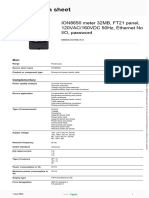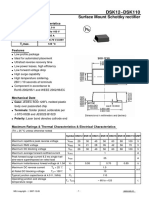Silicon Rectifier Diodes AC Adapters DO-41: Voltage 1 A Part 3 A Part
Silicon Rectifier Diodes AC Adapters DO-41: Voltage 1 A Part 3 A Part
Uploaded by
Malagala CharanCopyright:
Available Formats
Silicon Rectifier Diodes AC Adapters DO-41: Voltage 1 A Part 3 A Part
Silicon Rectifier Diodes AC Adapters DO-41: Voltage 1 A Part 3 A Part
Uploaded by
Malagala CharanOriginal Title
Copyright
Available Formats
Share this document
Did you find this document useful?
Is this content inappropriate?
Copyright:
Available Formats
Silicon Rectifier Diodes AC Adapters DO-41: Voltage 1 A Part 3 A Part
Silicon Rectifier Diodes AC Adapters DO-41: Voltage 1 A Part 3 A Part
Uploaded by
Malagala CharanCopyright:
Available Formats
The 1N4001 series (or 1N4000 series is a family of popular 1.
0 amp general purpose silicon rectifier diodes commonly used in AC adapters for common household appliances. Blocking voltage varies from 50 to 1000 volts. This diode is made in an axial-lead DO-41 plastic package. The 1N5400 series is a similarly popular series for higher current applications, up to 3 A. These diodes come in the larger DO-201 axial package These are fairly low-speed rectifier diodes, being inefficient for square waves of more than 15 kHz. The series was second sourced by many manufacturers. The 1N4000 series were in the Motorola Silicon Rectifier Handbook in 1966, as replacements for 1N2609 through 1N2617.The 1N5400 series were announced in Electrical Design News in 1968, along with the now lesser known 1.5-ampere 1N5391 series. These devices are widely used and recommended. The table below shows the maximum repetitive reverse blocking voltages of each of the members of the 1N4000 and 1N5400 series. Diode part numbers for different currents and voltages Voltage 1 A part 3 A part 50 V 100 V 200 V 300 V 400 V 500 V 600 V 800 V 1N4001 1N4002 1N4003 1N4004 1N4005 1N4006 1N5400 1N5401 1N5402 1N5403 1N5404 1N5405 1N5406 1N5407
1000 V 1N4007 1N5408 In the version of these components manufactured for Fairchild Semiconductor by Suzhou, the silicon chip that rectifies the current weighs just 93 micrograms. http://www.theladbible.com/media/emma-watson-sx-tape
2.1 What is 8051 Standard?
Microcontroller manufacturers have been competing for a long time for attracting choosy customers and every couple of days a new chip with a higher operating frequency, more memory and upgraded A/D converters appeared on the market. However, most of them had the same or at least very similar architecture known in the world of microcontrollers as 8051 compatible. What is all this about? The whole story has its beginnings in the far 80s when Intel launched the first series of microcontrollers called the MCS 051. Even though these microcontrollers had quite modest features in comparison to the new ones, they conquered the world very soon and became a standard for what nowadays is called the microcontroller. The main reason for their great success and popularity is a skillfully chosen configuration which satisfies different needs of a large number of users allowing at the same time constant expansions (refers to the new types of microcontrollers). Besides, the software has been developed in great extend in the meantime, and it simply was not profitable to change anything in the microcontrollers basic core. This is the reason for having a great number of various microcontrollers which basically are solely upgraded versions of the 8051 family. What makes this microcontroller so special and universal so that almost all manufacturers all over the world manufacture it today under different name?
As seen in figure above, the 8051 microcontroller has nothing impressive in appearance:
4 Kb of ROM is not much at all. 128b of RAM (including SFRs) satisfies the user's basic needs.
4 ports having in total of 32 input/output lines are in most cases sufficient to make all necessary connections to peripheral environment.
The whole configuration is obviously thought of as to satisfy the needs of most programmers working on development of automation devices. One of its advantages is that nothing is missing and nothing is too much. In other words, it is created exactly in accordance to the average users taste and needs. Another advantages are RAM organization, the operation of Central Processor Unit (CPU) and ports which completely use all recourses and enable further upgrade.
2.2 Pinout Description
Pins 1-8: Port 1 Each of these pins can be configured as an input or an output. Pin 9: RS A logic one on this pin disables the microcontroller and clears the contents of most registers. In other words, the positive voltage on this pin resets the microcontroller. By applying logic zero to this pin, the program starts execution from the beginning. Pins10-17: Port 3 Similar to port 1, each of these pins can serve as general input or output. Besides, all of them have alternative functions: Pin 10: RXD Serial asynchronous communication input or Serial synchronous communication output. Pin 11: TXD Serial asynchronous communication output or Serial synchronous communication clock output. Pin 12: INT0 Interrupt 0 input. Pin 13: INT1 Interrupt 1 input. Pin 14: T0 Counter 0 clock input. Pin 15: T1 Counter 1 clock input. Pin 16: WR Write to external (additional) RAM. Pin 17: RD Read from external RAM. Pin 18, 19: X2, X1 Internal oscillator input and output. A quartz crystal which specifies operating frequency is usually connected to these pins. Instead of it, miniature ceramics resonators can also be used for frequency stability. Later versions of microcontrollers operate at a frequency of 0 Hz up to over 50 Hz. Pin 20: GND Ground.
Pin 21-28: Port 2 If there is no intention to use external memory then these port pins are configured as general inputs/outputs. In case external memory is used, the higher address byte, i.e. addresses A8-A15 will appear on this port. Even though memory with capacity of 64Kb is not used, which means that not all eight port bits are used for its addressing, the rest of them are not available as inputs/outputs. Pin 29: PSEN If external ROM is used for storing program then a logic zero (0) appears on it every time the microcontroller reads a byte from memory. Pin 30: ALE Prior to reading from external memory, the microcontroller puts the lower address byte (A0-A7) on P0 and activates the ALE output. After receiving signal from the ALE pin, the external register (usually 74HCT373 or 74HCT375 add-on chip) memorizes the state of P0 and uses it as a memory chip address. Immediately after that, the ALU pin is returned its previous logic state and P0 is now used as a Data Bus. As seen, port data multiplexing is performed by means of only one additional (and cheap) integrated circuit. In other words, this port is used for both data and address transmission. Pin 31: EA By applying logic zero to this pin, P2 and P3 are used for data and address transmission with no regard to whether there is internal memory or not. It means that even there is a program written to the microcontroller, it will not be executed. Instead, the program written to external ROM will be executed. By applying logic one to the EA pin, the microcontroller will use both memories, first internal then external (if exists). Pin 32-39: Port 0 Similar to P2, if external memory is not used, these pins can be used as general inputs/outputs. Otherwise, P0 is configured as address output (A0-A7) when the ALE pin is driven high (1) or as data output (Data Bus) when the ALE pin is driven low (0). Pin 40: VCC +5V power supply.
2.3 Input/Output Ports (I/O Ports)
All 8051 microcontrollers have 4 I/O ports each comprising 8 bits which can be configured as inputs or outputs. Accordingly, in total of 32 input/output pins enabling the microcontroller to be connected to peripheral devices are available for use. Pin configuration, i.e. whether it is to be configured as an input (1) or an output (0), depends on its logic state. In order to configure a microcontroller pin as an input, it is necessary to apply a logic zero (0) to appropriate I/O port bit. In this case, voltage level on appropriate pin will be 0. Similarly, in order to configure a microcontroller pin as an input, it is necessary to apply a logic one (1) to appropriate port. In this case, voltage level on appropriate pin will be 5V (as is the case with any TTL input). This may seem confusing but don't loose your patience. It all becomes clear after studying simple electronic circuits connected to an I/O pin.
Input/Output (I/O) pin Figure above illustrates a simplified schematic of all circuits within the microcontroler connected to one of its pins. It refers to all the pins except those of the P0 port which do not have pull-up resistors built-in.
Output pin A logic zero (0) is applied to a bit of the P register. The output FE transistor is turned on, thus connecting the appropriate pin to ground.
Input pin A logic one (1) is applied to a bit of the P register. The output FE transistor is turned off and the appropriate pin remains connected to the power supply voltage over a pull-up resistor of high resistance. Port 0 The P0 port is characterized by two functions. If external memory is used then the lower address byte (addresses A0-A7) is applied on it. Otherwise, all bits of this port are configured as inputs/outputs. The other function is expressed when it is configured as an output. Unlike other ports consisting of pins with built-in pull-up resistor connected by its end to 5 V power supply, pins of this port have this resistor left out. This apparently small difference has its consequences:
If any pin of this port is configured as an input then it acts as if it floats. Such an input has unlimited input resistance and indetermined potential.
When the pin is configured as an output, it acts as an open drain. By applying logic 0 to a port bit, the appropriate pin will be connected to ground (0V). By applying logic 1, the external output will keep on floating. In order to apply logic 1 (5V) on this output pin, it is necessary to built in an external pull-up resistor. Port 1
P1 is a true I/O port, because it doesn't have any alternative functions as is the case with P0, but can be cofigured as general I/O only. It has a pull-up resistor built-in and is completely compatible with TTL circuits. Port 2 P2 acts similarly to P0 when external memory is used. Pins of this port occupy addresses intended for external memory chip. This time it is about the higher address byte with addresses A8-A15. When no memory is added, this port can be used as a general input/output port showing features similar to P1. Port 3 All port pins can be used as general I/O, but they also have an alternative function. In order to use these alternative functions, a logic one (1) must be applied to appropriate bit of the P3 register. In tems of hardware, this port is similar to P0, with the difference that its pins have a pull-up resistor built-in.
2.4 Memory Organization
The 8051 has two types of memory and these are Program Memory and Data Memory. Program Memory (ROM) is used to permanently save the program being executed, while Data Memory (RAM) is used for temporarily storing data and intermediate results created and used during the operation of the microcontroller. Depending on the model in use (we are still talking about the 8051 microcontroller family in general) at most a few Kb of ROM and 128 or 256 bytes of RAM is used. However All 8051 microcontrollers have a 16-bit addressing bus and are capable of addressing 64 kb memory. It is neither a mistake nor a big ambition of engineers who were working on basic core development. It is a matter of smart memory organization which makes these microcontrollers a real programmers goody.
You might also like
- Icetro Ice Cream MachineDocument56 pagesIcetro Ice Cream MachineSalman KapoorNo ratings yet
- Automatic Car Parking System Using 89c51 MicrocontrollerDocument61 pagesAutomatic Car Parking System Using 89c51 MicrocontrollerAnil Tandon63% (16)
- Project Report On Microcontroller Based Traffic Light Controller.Document22 pagesProject Report On Microcontroller Based Traffic Light Controller.Ayan Samanta80% (10)
- 2.1 What Is 8051 Standard?Document7 pages2.1 What Is 8051 Standard?Leena GhiwdondeNo ratings yet
- Chapter 2: 8051 Microcontroller Architecture: 2.1 What Is 8051 Standard?Document46 pagesChapter 2: 8051 Microcontroller Architecture: 2.1 What Is 8051 Standard?వంశీ క్రిష్ణNo ratings yet
- 8051 StandardDocument40 pages8051 StandardHARISH KONDURUNo ratings yet
- 2.1 What Is 8051 Standard?Document27 pages2.1 What Is 8051 Standard?Geo BabuNo ratings yet
- 15 01 06 16 14 27 3077 MkumarDocument94 pages15 01 06 16 14 27 3077 MkumarVasantha KumariNo ratings yet
- 2.2 Pinout DescriptionDocument27 pages2.2 Pinout DescriptionDeepak DineshNo ratings yet
- Chapter 2 - 8051 Microcontroller ArchitectureDocument27 pagesChapter 2 - 8051 Microcontroller ArchitectureAgxin M J Xavier100% (1)
- Microcontroller Record 8051Document50 pagesMicrocontroller Record 8051netgalaxy2010No ratings yet
- Distance Measurement SystemDocument31 pagesDistance Measurement Systemnikhitha100% (1)
- 8051 Microcontroller Unit 4Document49 pages8051 Microcontroller Unit 4pachavaleelaramya69No ratings yet
- Notes Unit 1Document8 pagesNotes Unit 1Dr. Rajalakshmi MNo ratings yet
- 8051 MicrocontrollerDocument33 pages8051 Microcontrollerchanoch254No ratings yet
- Project ReportDocument20 pagesProject ReportPiyush GuptaNo ratings yet
- 8051 Microcontroller PDFDocument31 pages8051 Microcontroller PDFHarshitha bottaNo ratings yet
- 89c51 MCUDocument16 pages89c51 MCUyuvakiraniNo ratings yet
- 4363741911Document26 pages4363741911Arnav Singh100% (1)
- Overview of 8051 MicrocontrollerDocument24 pagesOverview of 8051 MicrocontrolleryuriNo ratings yet
- Microcontroller 8051 - IntroductionDocument25 pagesMicrocontroller 8051 - IntroductionE.VigneshNo ratings yet
- 8051 Vs Motorola 68HC11Document19 pages8051 Vs Motorola 68HC11zuanne83No ratings yet
- MPMC-Unit-2 NOTESDocument43 pagesMPMC-Unit-2 NOTESBhure VedikaNo ratings yet
- Microprocessor Lab Manual EE0310Document44 pagesMicroprocessor Lab Manual EE0310sathishkumar.vNo ratings yet
- Over View of Microcontroller Part 1Document10 pagesOver View of Microcontroller Part 1langthasabibekNo ratings yet
- Power Supply:: TransformerDocument17 pagesPower Supply:: Transformerobula863No ratings yet
- Lecture 2 IO Ports and 8051 CircuitDocument3 pagesLecture 2 IO Ports and 8051 Circuit12343567890No ratings yet
- ATmega 328Document6 pagesATmega 328Wafik RkabNo ratings yet
- DevasheeshDocument17 pagesDevasheeshDevasheesh ManglaNo ratings yet
- Lab1 FinalDocument6 pagesLab1 FinalsufyanNo ratings yet
- Light Snsor31Document50 pagesLight Snsor31Sakshi TyagiNo ratings yet
- Introduction To Project: Chapter-1Document31 pagesIntroduction To Project: Chapter-1amit6357100% (1)
- 3.3 Microcontroller:: Fig: 3.2: MicrocontrollersDocument20 pages3.3 Microcontroller:: Fig: 3.2: Microcontrollersnafisa sultanaNo ratings yet
- MC Lab-Record Final - Watermark-1Document116 pagesMC Lab-Record Final - Watermark-1Mohamed SaleelNo ratings yet
- 8051 Notes 5 - Pin configuration & input output portsDocument3 pages8051 Notes 5 - Pin configuration & input output portsAnkit DeyNo ratings yet
- Unit 3Document10 pagesUnit 3Prasad ghumareNo ratings yet
- MP Lab 4 ZainDocument9 pagesMP Lab 4 ZainUmar KhanNo ratings yet
- Digital Thermometer Final ReportDocument22 pagesDigital Thermometer Final Reportrayedkhan100% (2)
- System Description: Microcontroller (AT89S52)Document19 pagesSystem Description: Microcontroller (AT89S52)Ayush SharmaNo ratings yet
- 89s52 Micro ControllerDocument14 pages89s52 Micro ControllerThanga PazhamNo ratings yet
- MIcrocontroller Based Embedded System E - ContentsDocument54 pagesMIcrocontroller Based Embedded System E - ContentsLokesh SharmaNo ratings yet
- 8051 Microcontroller Pin DiagramDocument2 pages8051 Microcontroller Pin DiagramsabirNo ratings yet
- Auto LightDocument37 pagesAuto LightKrishna MalhotraNo ratings yet
- Battery Operated Coin BasedDocument22 pagesBattery Operated Coin BasedMujahid Karwar50% (4)
- Microcontroller 8051Document27 pagesMicrocontroller 8051Amandeep SinghNo ratings yet
- 8051 MicrocontrollerDocument46 pages8051 MicrocontrollerSajid Hossain KhanNo ratings yet
- 8051 MicrocontrollerDocument20 pages8051 MicrocontrollerVIVEK CHAUDHARYNo ratings yet
- Microcontroller Lab Manual With Arduino Programe PDFDocument63 pagesMicrocontroller Lab Manual With Arduino Programe PDFTejasaiNo ratings yet
- PIC16F877A Introduction and FeaturesDocument8 pagesPIC16F877A Introduction and FeaturesChathura DalugodaNo ratings yet
- 15EE305J Microcontroller LabDocument82 pages15EE305J Microcontroller LabEngr. Muhammad Shahid Laiq Research Associate NCAINo ratings yet
- Microcontroller Based LPG Gas Detector Using GSM ModuleDocument22 pagesMicrocontroller Based LPG Gas Detector Using GSM ModuleKrishna MalhotraNo ratings yet
- Smart Building Using PIR SensorDocument16 pagesSmart Building Using PIR SensorSiva KumarNo ratings yet
- PLC Microcontroller 13-04-2020Document5 pagesPLC Microcontroller 13-04-2020jodxbagira.18No ratings yet
- 03 8051 Architecture1Document35 pages03 8051 Architecture1harinkhedetNo ratings yet
- Embedded Systems - 8051 MicrocontrollerDocument33 pagesEmbedded Systems - 8051 MicrocontrollerAarti DhotreNo ratings yet
- Bidirectional Visitor CounterDocument17 pagesBidirectional Visitor CounterPankaj KumarNo ratings yet
- 2020 - Mca Solved PaperDocument5 pages2020 - Mca Solved Paperaniketkumarverma475No ratings yet
- Primer Tutorial On 8051Document21 pagesPrimer Tutorial On 8051ChanderKishoreJoshiNo ratings yet
- Radio Shack TRS-80 Expansion Interface: Operator's Manual: Catalog Numbers: 26-1140, 26-1141, 26-1142From EverandRadio Shack TRS-80 Expansion Interface: Operator's Manual: Catalog Numbers: 26-1140, 26-1141, 26-1142No ratings yet
- Electronics Today 1979 03Document100 pagesElectronics Today 1979 03cornel_24100% (1)
- Control BitsDocument2 pagesControl BitsSri RamNo ratings yet
- Data Encoding & TransmissionDocument37 pagesData Encoding & Transmissionheaven letaNo ratings yet
- Power Elect 2 SHEET 2Document2 pagesPower Elect 2 SHEET 2رامي الزيباويNo ratings yet
- TUR.3006.0514 - TS300 Self Powered Digital GovernorDocument2 pagesTUR.3006.0514 - TS300 Self Powered Digital Governor9kd9njwkmvNo ratings yet
- Class 2 Sound Level Meter & Sound Exposure MeterDocument4 pagesClass 2 Sound Level Meter & Sound Exposure MeterEduart JamakuNo ratings yet
- Industrial Training VDocument15 pagesIndustrial Training VvijayNo ratings yet
- Digital Temperature Controller Operation Instruction: . Technical SpecificationDocument2 pagesDigital Temperature Controller Operation Instruction: . Technical SpecificationAlberth VillotaNo ratings yet
- Lanzar Htg157 User ManualDocument23 pagesLanzar Htg157 User ManualautreraNo ratings yet
- RFQ - EbpxDocument4 pagesRFQ - EbpxSunil PatelNo ratings yet
- SkyView System Installation Guide-Rev W v14 0 PDFDocument496 pagesSkyView System Installation Guide-Rev W v14 0 PDFsdghjaklNo ratings yet
- 1986-0040-EL-SPE03-0001 RA Specification For Bulk MaterialsDocument16 pages1986-0040-EL-SPE03-0001 RA Specification For Bulk MaterialsjmohammadrezaNo ratings yet
- MBC25081 Drive StepperDocument7 pagesMBC25081 Drive StepperLuis PalenciaNo ratings yet
- Inversor 6.2kw Mps v3Document1 pageInversor 6.2kw Mps v3Fernando VasquezNo ratings yet
- Load SchedDocument9 pagesLoad SchedXander DelinyaNo ratings yet
- 1 Product M8650C4C0H5E1A1ADocument5 pages1 Product M8650C4C0H5E1A1AFandi SaragihNo ratings yet
- Lab Report EeDocument10 pagesLab Report EepatilofoceanNo ratings yet
- Sensorless Field Oriented Control For A Permanent Magnet Synchronous Motor Using Sliding Mode DS00004398Document28 pagesSensorless Field Oriented Control For A Permanent Magnet Synchronous Motor Using Sliding Mode DS00004398about.mim.hosseiniNo ratings yet
- Primena SFRA Metode I Cilju Procene Stanja I Životnog Veka Energetskih TransformatoraDocument10 pagesPrimena SFRA Metode I Cilju Procene Stanja I Životnog Veka Energetskih Transformatoraturbo385No ratings yet
- Pdtspec4 01 (MIB 202)Document4 pagesPdtspec4 01 (MIB 202)Bala MNo ratings yet
- Reemplazo de FuentesDocument2 pagesReemplazo de FuentesMarcelo Fabián OrtizNo ratings yet
- Abbrev eDocument12 pagesAbbrev eamanatbuttNo ratings yet
- Accuload IV ManualDocument86 pagesAccuload IV ManualBahaa HasanNo ratings yet
- Automatic Railway Gate Control System - Circuit & Source CodeDocument18 pagesAutomatic Railway Gate Control System - Circuit & Source CodeSharukNo ratings yet
- Impulse Generator DatasheetDocument4 pagesImpulse Generator DatasheetaprilswapnilNo ratings yet
- Electrical Aptitude AssessmentDocument11 pagesElectrical Aptitude AssessmentdestawNo ratings yet
- 2 StepperDocument35 pages2 StepperAhmed SapryNo ratings yet
- L24 - Deadbeat Response Design - Sampled Data Control Systems With Deadbeat ResponseDocument6 pagesL24 - Deadbeat Response Design - Sampled Data Control Systems With Deadbeat ResponseKhi VuNo ratings yet
- DatasheetDocument2 pagesDatasheetالملك العقربNo ratings yet

























































































